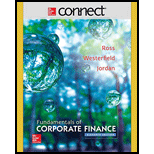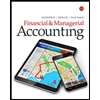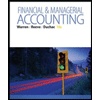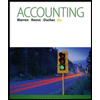
Connect 1 Semester Access Card for Fundamentals of Corporate Finance
11th Edition
ISBN: 9781259289392
Author: Stephen A. Ross Franco Modigliani Professor of Financial Economics Professor, Randolph W Westerfield Robert R. Dockson Deans Chair in Bus. Admin., Bradford D Jordan Professor
Publisher: McGraw-Hill Education
expand_more
expand_more
format_list_bulleted
Concept explainers
Question
Chapter 20, Problem 13QP
Summary Introduction
To prove: The derivation of economic order quantity (EOQ).
Introduction:
Economic order quantity refers to a model or tool designed for reducing the total costs (carrying costs and ordering costs) of the inventory.
Expert Solution & Answer
Want to see the full answer?
Check out a sample textbook solution
Students have asked these similar questions
Data is not clear then comment please
If image is not clear then comment.
This is finance question
Chapter 20 Solutions
Connect 1 Semester Access Card for Fundamentals of Corporate Finance
Ch. 20.1 - Prob. 20.1ACQCh. 20.1 - Prob. 20.1BCQCh. 20.2 - What considerations enter into the determination...Ch. 20.2 - Explain what terms of 3/45, net 90 mean. What is...Ch. 20.3 - Prob. 20.3ACQCh. 20.3 - Explain how to estimate the NPV of a credit policy...Ch. 20.4 - What are the carrying costs of granting credit?Ch. 20.4 - What are the opportunity costs of not granting...Ch. 20.4 - Prob. 20.4CCQCh. 20.5 - Prob. 20.5ACQ
Ch. 20.5 - Prob. 20.5BCQCh. 20.6 - Prob. 20.6ACQCh. 20.6 - What is an aging schedule?Ch. 20.7 - What are the different types of inventory?Ch. 20.7 - What are three things to remember when examining...Ch. 20.7 - Prob. 20.7CCQCh. 20.8 - Prob. 20.8ACQCh. 20.8 - Which cost component of the EOQ model does JIT...Ch. 20.A - Prob. 1ACQCh. 20.A - Prob. 1BCQCh. 20.A - Evaluating Credit Policy [LO2] Bismark Co. is in...Ch. 20.A - Credit Policy Evaluation [LO2] The Johnson Company...Ch. 20.A - Prob. 3QPCh. 20.A - Prob. 4QPCh. 20.A - Prob. 5QPCh. 20 - What is the difference between the accounts...Ch. 20 - Prob. 20.2CTFCh. 20 - Prob. 20.7CTFCh. 20 - Prob. 1CRCTCh. 20 - Prob. 2CRCTCh. 20 - Prob. 3CRCTCh. 20 - Five Cs of Credit [LO1] What are the five Cs of...Ch. 20 - Prob. 5CRCTCh. 20 - Prob. 6CRCTCh. 20 - Prob. 7CRCTCh. 20 - Prob. 8CRCTCh. 20 - Prob. 9CRCTCh. 20 - Prob. 10CRCTCh. 20 - Prob. 1QPCh. 20 - Size of Accounts Receivable [LO1] The Red Zeppelin...Ch. 20 - Prob. 3QPCh. 20 - Prob. 4QPCh. 20 - Terms of Sale [LO1] A firm offers terms of 1/10,...Ch. 20 - Prob. 6QPCh. 20 - Prob. 7QPCh. 20 - Prob. 8QPCh. 20 - Evaluating Credit Policy [LO2] Air Spares is a...Ch. 20 - Prob. 10QPCh. 20 - Prob. 11QPCh. 20 - Prob. 12QPCh. 20 - Prob. 13QPCh. 20 - Prob. 14QPCh. 20 - Prob. 15QPCh. 20 - Prob. 16QPCh. 20 - Prob. 17QPCh. 20 - Prob. 18QPCh. 20 - Prob. 19QPCh. 20 - Prob. 20QPCh. 20 - Prob. 21QPCh. 20 - Prob. 22QPCh. 20 - Credit Policy at Howlett Industries Sterling...Ch. 20 - Prob. 2M
Knowledge Booster
Learn more about
Need a deep-dive on the concept behind this application? Look no further. Learn more about this topic, finance and related others by exploring similar questions and additional content below.Similar questions
- What is the annotaion? Please help give some examples.arrow_forwardItem 2 Sequoia Furniture Company’s sales over the past three months, half of which are for cash, were as follows: March April May $ 426,000 $ 676,000 $ 546,000 Assume that Sequoia’s collection period is 60 days. What would be its cash receipts in May? What would be its accounts receivable balance at the end of May? Now assume that Sequoia’s collection period is 45 days. What would be its cash receipts in May? What would be its accounts receivable balance at the end of May?arrow_forwardAndres Michael bought a new boat. He took out a loan for $23,600 at 3.25% interest for 3 years. He made a $4,120 partial payment at 3 months and another partial payment of $3,440 at 6 months. How much is due at maturity?arrow_forward
- On May 3, 2020, Leven Corporation negotiated a short-term loan of $840,000. The loan is due October 1, 2020, and carries a 6.60% interest rate. Use ordinary interest to calculate the interest. What is the total amount Leven would pay on the maturity date? (Use Days in a year table.)arrow_forwardNolan Walker decided to buy a used snowmobile since his credit union was offering such low interest rates. He borrowed $4,300 at 3.75% on December 26, 2021, and paid it off February 21, 2023. How much did he pay in interest? (Assume ordinary interest and no leap year.) (Use Days in a year table.)arrow_forwardAnswer finance problem with correct given values do not assume any values. and no chatgptarrow_forward
arrow_back_ios
SEE MORE QUESTIONS
arrow_forward_ios
Recommended textbooks for you
 Financial & Managerial AccountingAccountingISBN:9781337119207Author:Carl Warren, James M. Reeve, Jonathan DuchacPublisher:Cengage Learning
Financial & Managerial AccountingAccountingISBN:9781337119207Author:Carl Warren, James M. Reeve, Jonathan DuchacPublisher:Cengage Learning Financial & Managerial AccountingAccountingISBN:9781285866307Author:Carl Warren, James M. Reeve, Jonathan DuchacPublisher:Cengage Learning
Financial & Managerial AccountingAccountingISBN:9781285866307Author:Carl Warren, James M. Reeve, Jonathan DuchacPublisher:Cengage Learning AccountingAccountingISBN:9781337272094Author:WARREN, Carl S., Reeve, James M., Duchac, Jonathan E.Publisher:Cengage Learning,
AccountingAccountingISBN:9781337272094Author:WARREN, Carl S., Reeve, James M., Duchac, Jonathan E.Publisher:Cengage Learning, Accounting (Text Only)AccountingISBN:9781285743615Author:Carl Warren, James M. Reeve, Jonathan DuchacPublisher:Cengage Learning
Accounting (Text Only)AccountingISBN:9781285743615Author:Carl Warren, James M. Reeve, Jonathan DuchacPublisher:Cengage Learning Intermediate Accounting: Reporting And AnalysisAccountingISBN:9781337788281Author:James M. Wahlen, Jefferson P. Jones, Donald PagachPublisher:Cengage Learning
Intermediate Accounting: Reporting And AnalysisAccountingISBN:9781337788281Author:James M. Wahlen, Jefferson P. Jones, Donald PagachPublisher:Cengage Learning

Financial & Managerial Accounting
Accounting
ISBN:9781337119207
Author:Carl Warren, James M. Reeve, Jonathan Duchac
Publisher:Cengage Learning


Financial & Managerial Accounting
Accounting
ISBN:9781285866307
Author:Carl Warren, James M. Reeve, Jonathan Duchac
Publisher:Cengage Learning

Accounting
Accounting
ISBN:9781337272094
Author:WARREN, Carl S., Reeve, James M., Duchac, Jonathan E.
Publisher:Cengage Learning,

Accounting (Text Only)
Accounting
ISBN:9781285743615
Author:Carl Warren, James M. Reeve, Jonathan Duchac
Publisher:Cengage Learning

Intermediate Accounting: Reporting And Analysis
Accounting
ISBN:9781337788281
Author:James M. Wahlen, Jefferson P. Jones, Donald Pagach
Publisher:Cengage Learning
Cost Classifications - Managerial Accounting- Fixed Costs Variable Costs Direct & Indirect Costs; Author: Accounting Instruction, Help, & How To;https://www.youtube.com/watch?v=QQd1_gEF1yM;License: Standard Youtube License